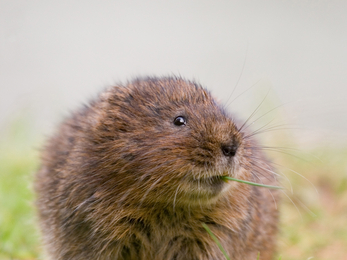Water voles are Britain’s largest voles, with fully grown adults reaching lengths of 20cm (plus a 12cm tail) and weighing up to 350g. They are charismatic little creatures with a round face, a blunt nose, a short furry tail and glossy dark brown or black fur. Water voles were popularised by the well-known character Ratty in Kenneth Grahame’s ‘Wind in the Willows’, who, despite his misleading name, is not a rat but a water vole.
In spite of their name, water voles are not particularly well-adapted to aquatic life. They have evolved to live alongside water to aid their escape from predators. Their characteristic ‘plop’ is the sound of them diving into the water to escape any would-be predator and to access the underwater entrance to their burrow. But they are clumsy swimmers, without the rudder-like tail or webbed feet evolved by other water-loving creatures.
Water voles live in burrows that they build by biting into the banks with their very strong, enamel-coated orange teeth. These burrows can be very complex and consist of nesting and nursing chambers, with two entrances, one on the bank and one underwater.
The breeding season begins in April and continues until October. Water voles are extremely successful breeders – they need to be to replenish the numbers lost during winter; when up to 80% of water voles perish, mainly as a result of starvation. Their babies (pups) leave the nest after three weeks and are themselves able to breed at 15 weeks old. One female water vole can have between five and six litters in a year, with between 3-5 pups per litter, meaning that one female water vole could have 25-30 babies in one breeding season – poor thing!
Water voles need to eat up to 80% of their own body weight every day in order to stay healthy. Their diet consists mainly of grasses and waterside plants, as well as twigs, bulbs, roots and fallen fruit. They aren’t too picky and have been recorded feeding on up to 220 different plants. Although they are described as herbivorous, a female feeding young will eat a dead water snail or fish if she comes across one, to boost her protein levels.

